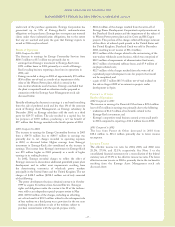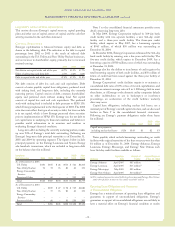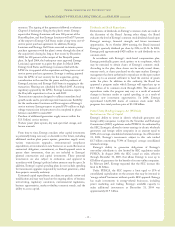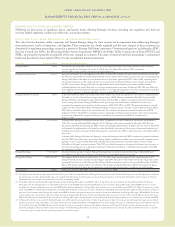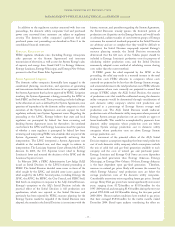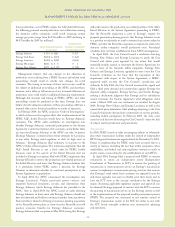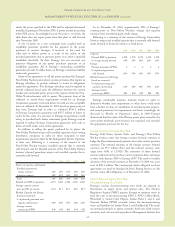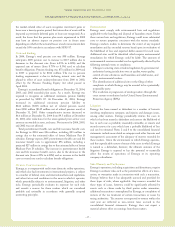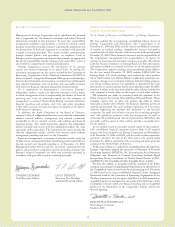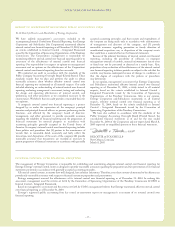Entergy 2004 Annual Report Download - page 39
Download and view the complete annual report
Please find page 39 of the 2004 Entergy annual report below. You can navigate through the pages in the report by either clicking on the pages listed below, or by using the keyword search tool below to find specific information within the annual report.
Entergy Corporation and Subsidiaries 2004
-37 -
Entergy also proposed to have the ICT administer a transmission
expansion pricing protocol that will increase the efficiency of
transmission pricing on the Entergy system and that will be
designed to protect Entergy’s native load customers from bearing
the cost of transmission upgrades not required to reliably serve these
customers’ needs. Entergy intends for the ICT to determine
whether transmission upgrades associated with new requests for
service should be funded directly by the party requesting such
service or by a broader group of transmission customers, including
Entergy’s native load customers. This determination would be made
in accordance with protocols approved by FERC and any party
contesting such determination, including Entergy, would be
required to seek review at FERC. Several technical conferences
regarding the ICT proposal, or various components thereof, were
held in 2004. Entergy has also responded to discovery requests that
resulted from these conferences.
In January 2005, Entergy filed a petition for declaratory order
with FERC requesting that FERC provide guidance on two
important issues: (1) whether the functions performed by the ICT
will cause it to become a “public utility” under the Federal Power
Act or the “transmission provider” under Entergy’s open access
transmission tariff; and (2) whether Entergy’s transmission pricing
proposal, as administered by the ICT, satisfies FERC’s transmission
pricing policy. The petition also indicates that, subject to the
outcome of the petition and obtaining support of Entergy’s retail
regulators, Entergywould be willing to havethe ICT perform the
following additional functions: (a) grant or deny requests for
transmission service; (b) calculate available flowgate capacity; (c)
administer Entergy’s OASIS; and (d) perform an enhanced
planning function(integrating the plans of Entergy and other
potential transmission owners to identify regional synergies.)
Comments and interventions on the petition were filed by market
participants and retail regulators on February 4, 2005. In their
individual comments, the APSC, LPSC, and City Council
supported Entergy’s position that the ICT would not become a
“public utility” or “transmission provider” and that the transmission
pricing proposal satisfies FERC’s transmission pricing policy.
Certain other parties urged FERC to reject the petition for
declaratory order or, in the alternative, that FERC assert
jurisdiction over the ICT and determine that Entergy’s proposed
pricing policy is inconsistent with FERC’s current pricing policy.
FERC action on the petition is expected during the first
half of 2005.
In March 2004, the APSC initiated a proceeding to review
Entergy’s proposal and compare the benefits of such a proposal to
the alternative of Entergy joining the Southwest Power Pool RTO.
The APSC sought comments from all interested parties on this
issue. Various parties, including the APSC General Staff, filed
comments opposing the ICT proposal. A public hearing has not
been scheduled by the APSC at this time, although Entergy
Arkansas has responded to various APSC data requests. In May
2004, Entergy Mississippi filed a petition for review with the
MPSC requesting MPSC support for the ICT proposal. A hearing
in that proceeding was held in August 2004. Additionally, Entergy
Louisiana and Entergy Gulf States have filed an application with
the LPSC requesting that the LPSC find that the ICT proposal is
aprudent and appropriate course of action. A hearing on the
transmission pricing aspects of the ICT proposal is scheduled for
May 2005, with a separate hearing on the WPP portion of the
proposal currently scheduled for August 2005.
FERC’s Supply Margin Assessment
In November 2001, FERC issued an order that established a new
generationmarket power screen (called Supply Margin Assessment)
for purposes of evaluating a utility’s request for market-based rate
authority, applied that new screen to the Entergy System (among
others), determined that Entergyand the others failed the screen
within their respectivecontrol areas, and ordered these utilities to
implement certain mitigation measures as a condition to their
continued abilityto buy and sellat market-based rates. Among
other things, the mitigationmeasures would require that Entergy
transact at cost-based rates when it sells in the hourly wholesale
market within its control area. Entergyrequested rehearing of the
order, and FERC delayed the implementation of certain mitigation
measures until suchtime as it had the opportunityto consider the
rehearing request. In June 2003, FERC proposed and ultimately
adopted newmarket behavior rules and tariff provisions that would
be applied to any market-based sale. Entergy modified its
market-based rate tariffs to reflect the new provisions but requested
rehearing of FERC’s order.
In April 2004, FERC issued its Order on Rehearing and
Modifying Interim Generation Market Power Analysis and
Mitigation Policy. In its April 2004 order, FERC established a new
interim generation market power analysis that will consider two
indicative market power screens: (1) the pivotal supplier screen that
is designed to measure an applicant’s market power based on the
applicant’s share of uncommitted capacity at the time of the control
area market’s annual peak demand; and (2) the market share screen
that is designed to evaluate an applicant’s market share of
uncommitted capacity on a seasonal basis. An integrated utility’s
native load obligation will be reflected in both screens; however,
the proxy for native load obligation differs between the screens. For
the uncommitted pivotal supplier screen, the proxy for native load is
the average of the daily native load peaks during the month in
which the annual peak load day occurs; for the uncommitted
market sharescreen the proxy for native load is the minimum peak
load dayfor eachseason. In the event an applicant fails either of
these screens, there will be a rebuttable presumption that market
“Entergy filed a proposal with FERC
to commit voluntarily to retain an independent entity
(Independent Coordinator of Transmission or ICT).”
MANAGEMENT’S FINANCIAL DISCUSSION and ANALYSIS continued


